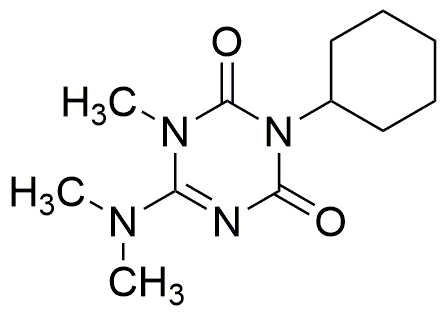Hexazinone is widely utilized in research focused on:
- Agricultural Herbicide: Primarily used in agriculture, it effectively controls a variety of weeds in crops such as sugarcane and pine forests, helping farmers increase yield and reduce competition for resources.
- Environmental Management: Employed in managing invasive plant species, hexazinone aids in restoring native ecosystems by selectively targeting unwanted vegetation without harming desirable plants.
- Research and Development: In laboratories, it serves as a standard for testing herbicide efficacy, allowing researchers to develop new formulations and improve existing products.
- Forestry Applications: Utilized in forestry to maintain clearings and promote the growth of desired tree species, contributing to sustainable forest management practices.
- Soil Health Studies: Hexazinone is used in studies examining soil health and weed management strategies, providing insights into effective agricultural practices and environmental impacts.
General Information
Properties
Safety and Regulations
Applications
Hexazinone is widely utilized in research focused on:
- Agricultural Herbicide: Primarily used in agriculture, it effectively controls a variety of weeds in crops such as sugarcane and pine forests, helping farmers increase yield and reduce competition for resources.
- Environmental Management: Employed in managing invasive plant species, hexazinone aids in restoring native ecosystems by selectively targeting unwanted vegetation without harming desirable plants.
- Research and Development: In laboratories, it serves as a standard for testing herbicide efficacy, allowing researchers to develop new formulations and improve existing products.
- Forestry Applications: Utilized in forestry to maintain clearings and promote the growth of desired tree species, contributing to sustainable forest management practices.
- Soil Health Studies: Hexazinone is used in studies examining soil health and weed management strategies, providing insights into effective agricultural practices and environmental impacts.
Documents
Safety Data Sheets (SDS)
The SDS provides comprehensive safety information on handling, storage, and disposal of the product.
Product Specification (PS)
The PS provides a comprehensive breakdown of the product’s properties, including chemical composition, physical state, purity, and storage requirements. It also details acceptable quality ranges and the product's intended applications.
Certificates of Analysis (COA)
Search for Certificates of Analysis (COA) by entering the products Lot Number. Lot and Batch Numbers can be found on a product’s label following the words ‘Lot’ or ‘Batch’.
*Catalog Number
*Lot Number
Certificates Of Origin (COO)
This COO confirms the country where the product was manufactured, and also details the materials and components used in it and whether it is derived from natural, synthetic, or other specific sources. This certificate may be required for customs, trade, and regulatory compliance.
*Catalog Number
*Lot Number
Safety Data Sheets (SDS)
The SDS provides comprehensive safety information on handling, storage, and disposal of the product.
DownloadProduct Specification (PS)
The PS provides a comprehensive breakdown of the product’s properties, including chemical composition, physical state, purity, and storage requirements. It also details acceptable quality ranges and the product's intended applications.
DownloadCertificates of Analysis (COA)
Search for Certificates of Analysis (COA) by entering the products Lot Number. Lot and Batch Numbers can be found on a product’s label following the words ‘Lot’ or ‘Batch’.
*Catalog Number
*Lot Number
Certificates Of Origin (COO)
This COO confirms the country where the product was manufactured, and also details the materials and components used in it and whether it is derived from natural, synthetic, or other specific sources. This certificate may be required for customs, trade, and regulatory compliance.


